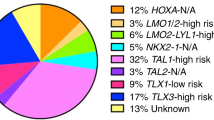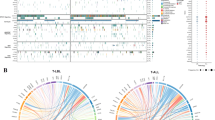Abstract
The T-lineage phenotype in children with acute lymphoblastic leukaemia (ALL) is associated with in vitro drug resistance and a higher relapse-risk compared to a precursor B phenotype. Our study was aimed to investigate whether mutations in the ATM gene occur in childhood T-lineage acute lymphoblastic leukaemia (T-ALL) that are linked to drug resistance and clinical outcome. In all, 20 different single nucleotide substitutions were found in 16 exons of ATM in 62/103 (60%) T-ALL children and 51/99 (52%, P=0.21) controls. Besides the well-known polymorphism D1853N, five other alterations (S707P, F858L, P1054R, L1472W, Y1475C) in the coding part of ATM were found. These five coding alterations seem to occur more frequently in T-ALL (13%) than controls (5%, P=0.06), but did not associate with altered expression levels of ATM or in vitro resistance to daunorubicin. However, T-ALL patients carrying these five coding alterations presented with a higher white blood cell count at diagnosis (P=0.05) and show an increased relapse-risk (5-year probability of disease-free survival (pDFS)=48%) compared to patients with other alterations or wild-type ATM (5-year pDFS=76%, P=0.05). The association between five coding ATM alterations in T-ALL, their germline presence, white blood cell count and unfavourable outcome may point to a role for ATM in the development of T-ALL in these children.
This is a preview of subscription content, access via your institution
Access options
Subscribe to this journal
Receive 12 print issues and online access
$259.00 per year
only $21.58 per issue
Buy this article
- Purchase on Springer Link
- Instant access to full article PDF
Prices may be subject to local taxes which are calculated during checkout



Similar content being viewed by others
References
Uziel T, Savitsky K, Platzer M, Ziv Y, Helbitz T, Nehls M et al. Genomic organization of the ATM gene. Genomics 1996; 33: 317–320.
Baskaran R, Wood LD, Whitaker LL, Canman CE, Morgan SE, Xu Y et al. Ataxia telangiectasia mutant protein activates c-Abl tyrosine kinase in response to ionizing radiation. Nature 1997; 387: 516–519.
Banin S, Moyal L, Shieh S, Taya Y, Anderson CW, Chessa L et al. Enhanced phosphorylation of p53 by ATM in response to DNA damage. Science 1998; 281: 1674–1677.
Lim DS, Kim ST, Xu B, Maser RS, Lin J, Petrini JH et al. ATM phosphorylates p95/nbs1 in an S-phase checkpoint pathway. Nature 2000; 404: 613–617.
Gatei M, Scott SP, Filippovitch I, Soronika N, Lavin MF, Weber B et al. Role for ATM in DNA damage-induced phosphorylation of BRCA1. Cancer Res 2000; 60: 3299–3304.
Wang H, Guan J, Perrault AR, Wang Y, Iliakis G . Replication protein A2 phosphorylation after DNA damage by the coordinated action of ataxia telangiectasia-mutated and DNA-dependent protein kinase. Cancer Res 2001; 61: 8554–8563.
Gatei M, Sloper K, Sorensen C, Syljuasen R, Falck J, Hobson K et al. Ataxia-telangiectasia-mutated (ATM) and NBS1-dependent phosphorylation of Chk1 on Ser-317 in response to ionizing radiation. J Biol Chem 2003; 278: 14806–14811.
Matsuoka S, Rotman G, Ogawa A, Shiloh Y, Tamai K, Elledge SJ . Ataxia telangiectasia-mutated phosphorylates Chk2 in vivo and in vitro. Proc Natl Acad Sci USA 2000; 97: 10389–10394.
Khosravi R, Maya R, Gottlieb T, Oren M, Shiloh Y, Shkedy D . Rapid ATM-dependent phosphorylation of MDM2 precedes p53 accumulation in response to DNA damage. Proc Natl Acad Sci USA 1999; 96: 14973–14977.
Bosotti R, Isacchi A, Sonnhammer EL . FAT: a novel domain in PIK-related kinases. Trends Biochem Sci 2000; 25: 225–227.
Khanna KK, Keating KE, Kozlov S, Scott S, Gatei M, Hobson K et al. ATM associates with and phosphorylates p53: mapping the region of interaction. Nat Genet 1998; 20: 398–400.
Shafman T, Khanna KK, Kedar P, Spring K, Kozlov S, Yen T et al. Interaction between ATM protein and c-Abl in response to DNA damage. Nature 1997; 387: 520–523.
Lim DS, Kirsch DG, Canman CE, Ahn JH, Ziv Y, Newman LS et al. ATM binds to beta-adaptin in cytoplasmic vesicles. Proc Natl Acad Sci USA 1998; 95: 10146–10151.
Chen S, Paul P, Price BD . ATM's leucine-rich domain and adjacent sequences are essential for ATM to regulate the DNA damage response. Oncogene 2003; 22: 6332–6339.
Khanna KK, Lavin MF, Jackson SP, Mulhern TD . ATM, a central controller of cellular responses to DNA damage. Cell Death Differ 2001; 8: 1052–1065.
Meyn MS . Ataxia-telangiectasia, cancer and the pathobiology of the ATM gene. Clin Genet 1999; 55: 289–304.
Taylor AM, Metcalfe JA, Thick J, Mak YF . Leukemia and lymphoma in ataxia telangiectasia. Blood 1996; 87: 423–438.
Pernin D, Bay JO, Uhrhammer N, Bignon YJ . ATM heterozygote cells exhibit intermediate levels of apoptosis in response to streptonigrin and etoposide. Eur J Cancer 1999; 35: 1130–1135.
Sugimoto K, Tamayose K, Takagi M, Yamada K, Sasaki M, Mizutani S et al. Activation of an ataxia telangiectasia mutation-dependent intra-S-phase checkpoint by anti-tumour drugs in HL-60 and human lymphoblastoid cells. Br J Haematol 2000; 110: 819–825.
Pieters R, den Boer ML, Durian M, Janka G, Schmiegelow K, Kaspers GJ et al. Relation between age, immunophenotype and in vitro drug resistance in 395 children with acute lymphoblastic leukemia—implications for treatment of infants. Leukemia 1998; 12: 1344–1348.
Kaspers GJ, Veerman AJ, Pieters R, Broekema GJ, Huismans DR, Kazemier KM et al. Mononuclear cells contaminating acute lymphoblastic leukaemic samples tested for cellular drug resistance using the methyl-thiazol-tetrazolium assay. Br J Cancer 1994; 70: 1047–1052.
Den Boer ML, Harms DO, Pieters R, Kazemier KM, Gobel U, Korholz D et al. Patient stratification based on prednisolone-vincristine-asparaginase resistance profiles in children with acute lymphoblastic leukemia. J Clin Oncol 2003; 21: 3262–3268.
Bernstein JL, Teraoka S, Haile RW, Borresen-Dale AL, Rosenstein BS, Gatti RA et al. Designing and implementing quality control for multi-center screening of mutations in the ATM gene among women with breast cancer. Hum Mutat 2003; 21: 542–550.
Stam RW, den Boer ML, Meijerink JP, Ebus ME, Peters GJ, Noordhuis P et al. Differential mRNA expression of Ara-C-metabolizing enzymes explains Ara-C sensitivity in MLL gene-rearranged infant acute lymphoblastic leukemia. Blood 2003; 101: 1270–1276.
Meijerink J, Mandigers C, van de Locht L, Tonnissen E, Goodsaid F, Raemaekers J . A novel method to compensate for different amplification efficiencies between patient DNA samples in quantitative real-time PCR. J Mol Diagn 2001; 3: 55–61.
Gumy-Pause F, Wacker P, Maillet P, Betts D, Sappino AP . ATM gene alterations in childhood acute lymphoblastic leukemias. Hum Mutat 2003; 21: 554.
Liberzon E, Avigad S, Stark B, Zilberstein J, Freedman L, Gorfine M et al. Germ-line ATM gene alterations are associated with susceptibility to sporadic T-cell acute lymphoblastic leukemia in children. Genes Chromosomes Cancer 2004; 39: 161–166.
Takeuchi S, Koike M, Park S, Seriu T, Bartram CR, Taub HE et al. The ATM gene and susceptibility to childhood T-cell acute lymphoblastic leukaemia. Br J Haematol 1998; 103: 536–538.
Luo L, Lu FM, Hart S, Foroni L, Rabbani H, Hammarstrom L et al. Ataxia-telangiectasia and T-cell leukemias: no evidence for somatic ATM mutation in sporadic T-ALL or for hypermethylation of the ATM-NPAT/E14 bidirectional promoter in T-PLL. Cancer Res 1998; 58: 2293–2297.
Starostik P, Manshouri T, O'Brien S, Freireich E, Kantarjian H, Haidar M et al. Deficiency of the ATM protein expression defines an aggressive subgroup of B-cell chronic lymphocytic leukemia. Cancer Res 1998; 58: 4552–4557.
Haidar MA, Kantarjian H, Manshouri T, Chang CY, O'Brien S, Freireich E et al. ATM gene deletion in patients with adult acute lymphoblastic leukemia. Cancer 2000; 88: 1057–1062.
Vorechovsky I, Luo L, Dyer MJ, Catovsky D, Amlot PL, Yaxley JC et al. Clustering of missense mutations in the ataxia-telangiectasia gene in a sporadic T-cell leukaemia. Nat Genet 1997; 17: 96–99.
Stilgenbauer S, Schaffner C, Litterst A, Liebisch P, Gilad S, Bar-Shira A et al. Biallelic mutations in the ATM gene in T-prolymphocytic leukemia. Nat Med 1997; 3: 1155–1159.
Stoppa-Lyonnet D, Soulier J, Lauge A, Dastot H, Garand R, Sigaux F et al. Inactivation of the ATM gene in T-cell prolymphocytic leukemias. Blood 1998; 91: 3920–3926.
Schaffner C, Stilgenbauer S, Rappold GA, Dohner H, Lichter P . Somatic ATM mutations indicate a pathogenic role of ATM in B-cell chronic lymphocytic leukemia. Blood 1999; 94: 748–753.
Stilgenbauer S, Winkler D, Ott G, Schaffner C, Leupolt E, Bentz M et al. Molecular characterization of 11q deletions points to a pathogenic role of the ATM gene in mantle cell lymphoma. Blood 1999; 94: 3262–3264.
Schaffner C, Idler I, Stilgenbauer S, Dohner H, Lichter P . Mantle cell lymphoma is characterized by inactivation of the ATM gene. Proc Natl Acad Sci USA 2000; 97: 2773–2778.
Stilgenbauer S, Schaffner C, Winkler D, Ott G, Leupolt E, Bentz M et al. The ATM gene in the pathogenesis of mantle-cell lymphoma. Ann Oncol 2000; 11 (Suppl 1): 127–130.
Camacho E, Hernandez L, Hernandez S, Tort F, Bellosillo B, Bea S et al. ATM gene inactivation in mantle cell lymphoma mainly occurs by truncating mutations and missense mutations involving the phosphatidylinositol-3 kinase domain and is associated with increasing numbers of chromosomal imbalances. Blood 2002; 99: 238–244.
Smith GC, d'Adda di Fagagna F, Lakin ND, Jackson SP . Cleavage and inactivation of ATM during apoptosis. Mol Cell Biol 1999; 19: 6076–6084.
Takagi M, Tsuchida R, Oguchi K, Shigeta T, Nakada S, Shimizu K et al. Identification and characterization of polymorphic variations of the ataxia telangiectasia-mutated (ATM) gene in childhood Hodgkin disease. Blood 2004; 103: 283–290.
Acknowledgements
This study is supported by The Sophia Foundation for Medical Research (Project number SSWO-322). We thank members of the Dutch Childhood Oncology Group (DCOG) and the German Cooperative Study Group for Childhood Acute Lymphoblastic Leukaemia (COALL) for their support of this study by collecting patient samples.
Author information
Authors and Affiliations
Corresponding author
Additional information
This study is supported by The Sophia Foundation for Medical Research (Project number SSWO-322).
Rights and permissions
About this article
Cite this article
Meier, M., den Boer, M., Hall, A. et al. Relation between genetic variants of the ataxia telangiectasia-mutated (ATM) gene, drug resistance, clinical outcome and predisposition to childhood T-lineage acute lymphoblastic leukaemia. Leukemia 19, 1887–1895 (2005). https://doi.org/10.1038/sj.leu.2403943
Received:
Accepted:
Published:
Issue Date:
DOI: https://doi.org/10.1038/sj.leu.2403943
Keywords
This article is cited by
-
Towards standardization of next-generation sequencing of FFPE samples for clinical oncology: intrinsic obstacles and possible solutions
Journal of Translational Medicine (2017)
-
Detection of ATM germline variants by the p53 mitotic centrosomal localization test in BRCA1/2-negative patients with early-onset breast cancer
Journal of Experimental & Clinical Cancer Research (2016)
-
Linking ATM Promoter Methylation to Cell Cycle Protein Expression in Brain Tumor Patients: Cellular Molecular Triangle Correlation in ATM Territory
Molecular Neurobiology (2015)
-
Folate metabolic gene polymorphisms and childhood acute lymphoblastic leukemia: a case–control study
Leukemia (2007)
-
Cancer Pharmacogenomics
Molecular Diagnosis & Therapy (2007)



